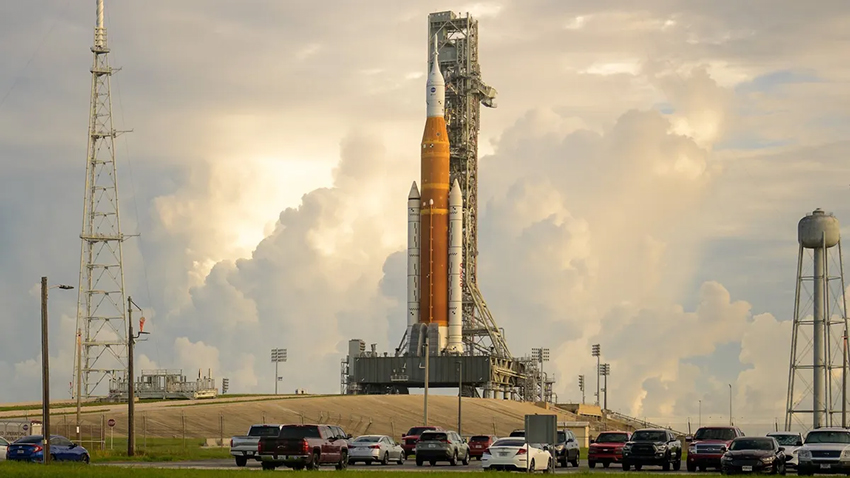|
INNOVATION
NASA's SLS hydrogen leak is a
sign of the Artemis program's outdated technology

SLS on the launch pad.
NASA's Space Launch System didn't launch
for the
second time of asking on Saturday, September 3, due to a large
hydrogen leak in a fuel line quick-disconnect fitting.
That leak is likely to delay the $23
billion SLS — NASA's
most powerful rocket to date — by several weeks, pushing the
launch into October.
Though the launch of SLS will kick
off NASA's
historic Artemis program, the latest delay is an indicator of
the fact the space agency is relying on old technology that was
originally designed for the Space Shuttle program. Experts have
warned for years that the launch of SLS will suffer from
difficulties that plagued the Shuttle program.
When will Artemis I launch?
The latest launch window ends today,
Tuesday, September 6, and NASA has already announced it won't be
attempting another launch during this window. The space agency is
still troubleshooting the issue. Depending on the outcome, NASA will
either keep SLS on the launch pad and perform a partial fueling test
to confirm their fix works or send it back to the Vehicle Assembly
Building for repairs.
The next launch window opens on September
19 and ends on October 4. However, SLS would have to be fixed on the
pad for a launch during that timeframe to go ahead. NASA's plans to
launch a new crew to the International Space Station on October 3
might also cause a scheduling conflict. That could mean the launch
would be pushed back to the next launch window running from October 17
to October 31.
#Artemis
Update: The team continues to troubleshoot, and plans to return
with a variety of options early next week. We are standing down on any
launch attempts through the current launch period, which ends Tuesday.

"This is an incredibly hard business,"
Artemis 1 mission manager Mike Sarafin explained,
as per CBS News. "Our focus is on understanding the
problem. ... We'll follow up next week when we have those options
flushed out further."
Hydrogen issues go back to the Space
Shuttle
NASA's SLS is the space agency's most
powerful rocket to date. Once it launches, it will be capable of
producing 9.5 million lbs of thrust to carry a payload capacity of
190,000 lbs (86 tons) up to low-Earth orbit (LEO).
Importantly though, the agency's newest
launch system isn't a complete departure from what came before.
The massive rocket is made primarily of adapted parts — such as
its four RS-25 engines on the core stage — that were originally
designed for the Space Shuttle program four decades ago.
NASA has faced criticism for using old
technologies in the face of new reusable tech geared towards more
sustainable and cost-effective rocket launches. The trouble is
NASA is using the same main engines used for the Space Shuttle, a
decision that was mandated when Congress wrote the authorization
bill for NASA in 2010. These use liquid hydrogen propellant and
liquid oxygen to serve as an oxidizer. As
Ars Technica points out, the shuttle scrubbed nearly
once every launch attempt throughout its lifetime, and the cause
was often hydrogen issues.
Hydrogen is the lightest element,
meaning it is surprisingly easy for leaks to occur. Though it is
efficient and it provides better "gas mileage" when used in rocket
engines, alternatives such as methane and kerosene are easier to
manage and would invariably lead to fewer scrubs on the launch
pad.
In an
August interview with IE, former NASA Deputy Administrator
Lori Garver said she pushed for the space agency to turn to
private companies for the Artemis program, but the "forces of the
status quo in government" were too strong. The result is a rocket
that has gone more than $10 billion over budget and whose launch
is more than five years late.
When it does eventually launch, though,
it will pave the way for the crewed Artemis II mission and then
Artemis III, which will use SpaceX's Starship as a lunar lander to
send humans back to the surface of the moon. Success would mean the
transition encouraged by Garver and many others is slowly but surely
taking shape.
Green Play Ammonia™, Yielder® NFuel Energy.
Spokane, Washington. 99212
www.exactrix.com
509 995 1879 cell, Pacific.
exactrix@exactrix.com
|